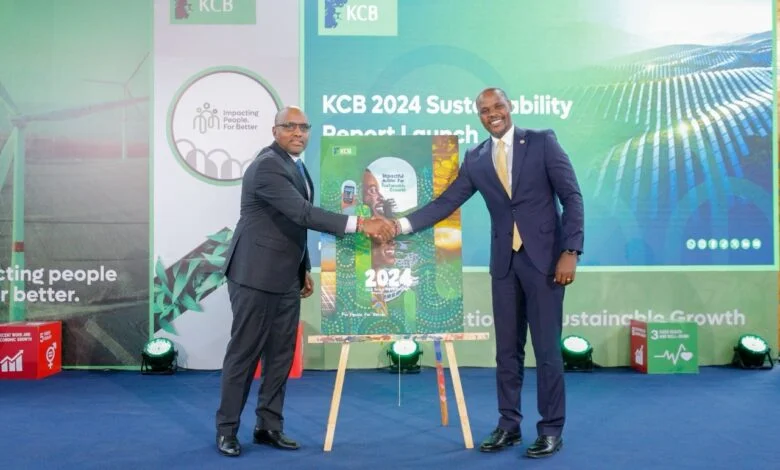KCB Group Doubles Down on Green Finance with $578 Billion Loan Screening Program

In a major strategic pivot, KCB Group, East Africa’s largest commercial bank, is re-engineering its financial machinery to prioritize climate action and sustainable development, moving beyond traditional banking to embed environmental and social governance into its core operations. The bank announced it screened a staggering KES 578.3 billion in loans for environmental and social risks in 2024, a move that signals a significant shift in its lending philosophy.
This isn’t just corporate jargon. The bank has put its money where its mouth is, disbursing KES 53.2 billion in green loans last year, boosting its green-tagged lending from 15% of its portfolio in 2023 to 21.32%. The goal is to hit 25% by 2025. These funds are being channeled into critical sectors like renewable energy, e-mobility, and the blue economy, backed by a rigorous verification process using the Climate Assessment for Financial Institutions (CAFI) tool to ensure transparency.
Rewiring the Core for Climate Risk
The most significant part of KCB’s strategy isn’t just the money, but the deep, structural changes to its risk management architecture. The bank has officially designated climate-related risk as a principal risk category within its Enterprise Risk Management (ERM) Framework. This means every major financial decision must now pass through a climate-impact filter.
To make this real, KCB is developing climate scenario analysis and stress-testing capabilities to model the financial impact of both physical climate disruptions and the economic transition to a low-carbon economy. This forward-looking approach is a step beyond mere compliance and is being audited independently by Deloitte, a first for a Kenyan financial institution. The bank is also an early adopter of the IFRS S1 and S2 international sustainability reporting standards, years ahead of the 2027 mandatory deadline, demonstrating a commitment to transparency.
The Tech Engine Behind the Green Shift
Driving this transformation is a heavy investment in technology and digital infrastructure. KCB’s strategy is twofold: using tech for operational efficiency and leveraging it for financial inclusion.
- Operational Overhaul: The bank is deploying AI-driven tools, cloud-based solutions, and advanced data analytics to streamline operations, cut costs, and reduce its own carbon footprint. This includes automating the capture of sustainability data to improve the accuracy of its reporting and decision-making.
- Inclusive Digital Banking: While investing in cutting-edge tech, KCB acknowledges the digital divide. The bank continues to support and optimize legacy platforms like USSD, which remain crucial for millions of customers with feature phones. Simultaneously, it is enhancing its mobile app by reducing data consumption and adding offline features to ensure accessibility in low-bandwidth areas.
- Building an Ecosystem: KCB is looking beyond its own walls, fostering a fintech ecosystem by offering its APIs to over 2,000 developers. This has enabled 355 fintechs and startups to build solutions on KCB’s infrastructure, particularly for payments. It has also launched Zed ERP, an affordable enterprise resource planning tool for small businesses, to help them digitize their operations without the high cost of typical enterprise software.
The Unvarnished Reality: Costs and Challenges
In its sustainability report, KCB openly discusses the difficult trade-offs involved in this ambitious transformation. The bank outlines the “high cost of digital ambition,” citing the massive capital required for AI, modernizing legacy systems, and cybersecurity. It frames cybersecurity not as a mere expense, but as the “rising price of digital trust” and a non-negotiable investment.
The report also points to “cultural inertia” as a silent tax on innovation, acknowledging that internal resistance to change and siloed operations can impede progress. This candid self-assessment provides a realistic picture of the immense challenges a legacy institution faces when trying to pivot at such a scale.
While grappling with these internal challenges, the bank’s social initiatives continue to scale. Its Female-Led and Made Enterprise (FLME) program has disbursed KES 139 billion since 2022, benefiting over 60,000 entrepreneurs. The KCB Foundation’s 2Jiajiri program has equipped thousands of youths with vocational skills, creating over 60,000 jobs.
Ultimately, KCB is making a calculated, long-term bet that the future of finance is inextricably linked to sustainability. As CEO Paul Russo stated, the goal is to “safeguard the Planet and People even as we pursue Profits”. The bank is building the complex technological and governance frameworks to prove that these three objectives don’t have to be mutually exclusive.